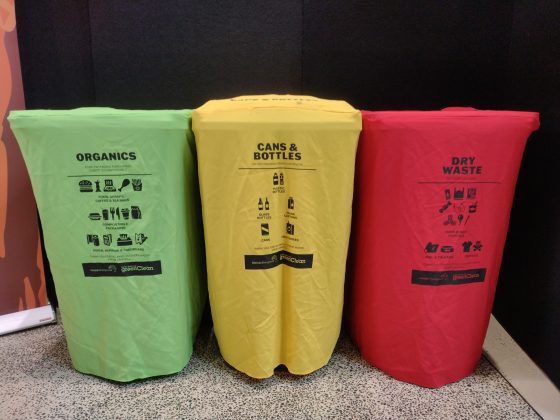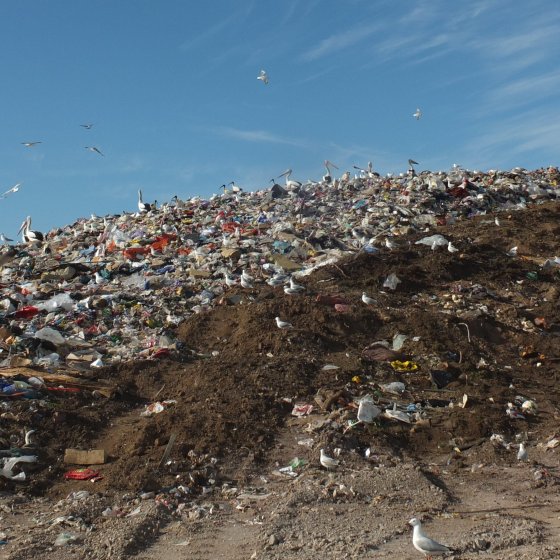Waste
Recovery and Disposal
South Australia’s Waste Strategy 2020-25 sets an overall target of zero avoidable waste to landfill by 2030. This target aims to guide our actions towards a circular economy. We came close to meeting our targets in 2020 for reducing waste to landfill by 35% from a 2002-03 baseline. However, we will need to implement further actions to meet targets for 2030.
'Unavoidable’ waste refers to wastes for which no other current treatment is available including (but not limited to) asbestos, toxic and quarantine waste.
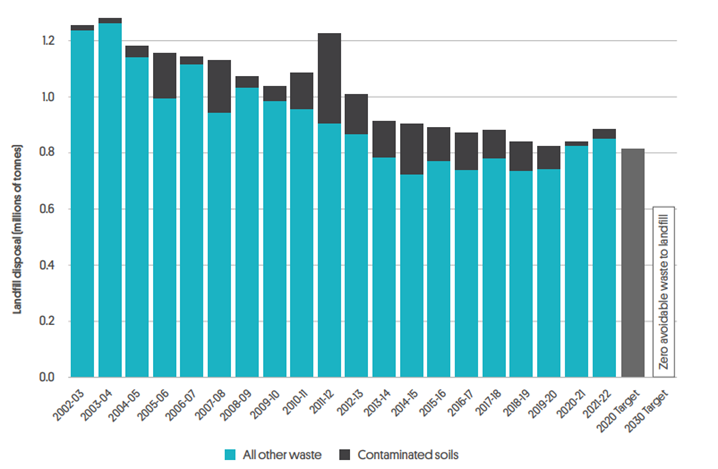
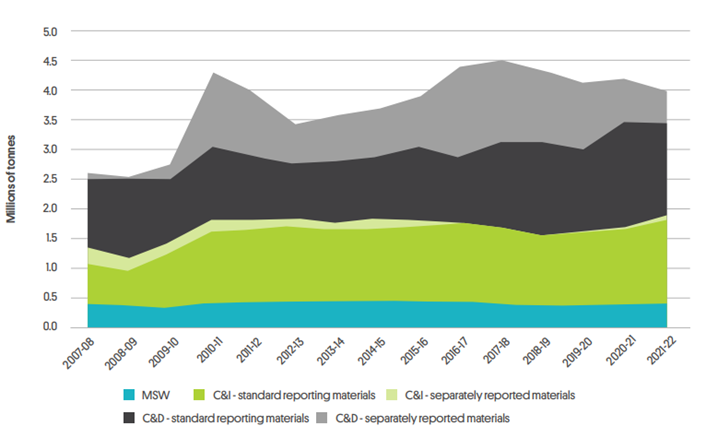

The trend of South Australia's transition to a circular economy has improved in the resource recovery sector since 2003–04. According to the 2021–22 Circular Economy Resource Recovery Report, there has been an overall 35.3% reduction in waste sent to landfill since 2003–04. The 2021–22 recovery rate for South Australia was 81.9% for all materials, which is down slightly from the 2020–21 rate when it was 83.3%. In 2021–22:
- 3.99 million tonnes of material was recovered (4.9% decrease from 2020–21)
- 885 kilo tonnes of waste was disposed to landfill (5.37% increase from 2020–21)
- overall waste generation was 4.88 million tonnes (3.17% decrease from 2020–21)
- waste generation per capita has decreased (2.68 tonnes per person compared to 3.09 tonnes per person in 2017–18).

In South Australia most landfill waste is from the municipal waste stream. Food waste makes up approximately 22% by weight of total kerbside household waste and 40% of residual waste being sent to landfill each year. Food waste diversion from landfill holds the most opportunity for kerbside performance improvement. A Valuing Our Food Waste (2020–2025) strategy to reduce and divert household and business food waste has been developed by Green Industries SA.
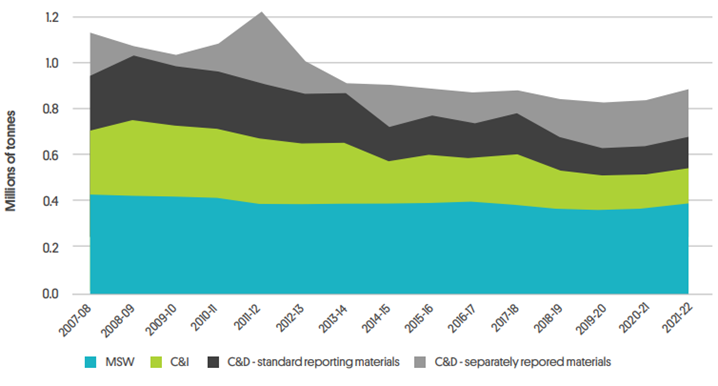
South Australia’s 20-year State Infrastructure Strategy Discussion Paper October 2023 highlights that while South Australia was an early adopter of technologies such as solar PVs, wind turbine generation and grid-scale storage using lithium-ion batteries, this also means we will be one of the first major developed jurisdictions to meet the challenges and opportunities to address end-of-life management of these materials. It is estimated that 50,000 tonnes of grid-scale solar PVs, 9,000 tonnes of wind turbines and 4,500 tonnes of battery energy storage systems will need to be managed per year by 2050 in South Australia alone. According to the discussion paper, at this stage, South Australia has little to no processing capabilities for grid-scale infrastructure waste streams and few planned beyond ideation stage.
Moving towards a Circular Economy
Circular economy is an economic model that aims to minimise waste, maximise resource efficiency and promote sustainability. It is a departure from the traditional linear economy, where resources are extracted, transformed into products, used and then discarded as waste. Green Industries SA and the EPA are helping drive our transition to a circular economy.
In a circular economy, the emphasis is on keeping products, materials and resources in use for as long as possible. It involves designing products with durability and reparability in mind, and when products reach the end of their useful life, the goal is to recover and regenerate the resources they contain, rather than disposing of them.
The circular economy is guided by three key principles:
- Designing out waste and pollution: This principle involves rethinking product design and manufacturing processes to eliminate waste, minimise environmental impact and reduce the use of harmful substances. It encourages the use of renewable materials and encourages companies to adopt eco-design and eco-innovation practices.
- Keeping products and materials in use for as long as possible: The aim is to extend the lifespan of products through reuse, repair, refurbishment and remanufacturing. This principle promotes the development of business models that focus on sharing, leasing and product-as-a-service arrangements, rather than solely relying on ownership and consumption.
- Regenerating natural systems: The circular economy recognises the importance of restoring and regenerating natural resources and ecosystems. It promotes the use of renewable energy, the adoption of sustainable agricultural practices and the restoration of natural habitats. It also encourages the recycling and recovery of materials to reduce reliance on virgin resources.

Container Deposit and Plastics
South Australia was the first jurisdiction in Australia to introduce a container deposit scheme in 1977, lightweight plastic bag ban in 2009 and legislation to ban the sale, supply and distribution of certain single-use plastic items under the South Australian Single-use and Other Plastics Products (Waste Avoidance) Act 2020.
The single-use plastics legislation is being reviewed to include additional single-use plastic products that are being banned over the next few years, as announced in 2022. Container deposit legislation is also being reviewed to modernise the container deposit scheme (CDS). Return rates for CDS beverage containers increased when the refund amount was increased from 5c to 10c and had an overall return rate of 76% in 2022–23 This equated to over 660 million containers returned and was worth more than $66 million refunded to the South Australian community. However, when compared with glass and aluminium, return rates are low for PET, most HDPE and paperboard carton products.
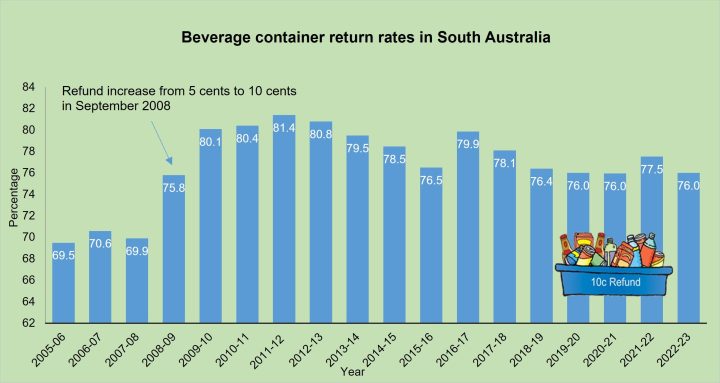
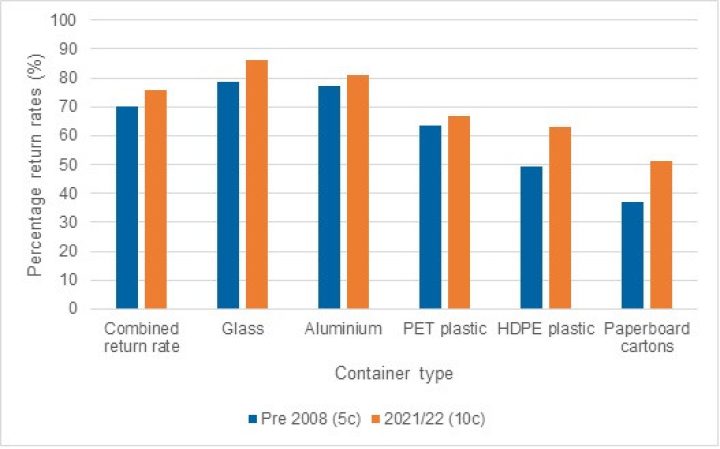
Recovery of plastics is increasing, with 33,000 tonnes being recovered in 2021–22, most of which being HDPE (35%), PET (28%) and LDPE (20%). However, during this period, it is estimated that plastic consumption in South Australia was 239,000 tonnes, with 190,000 tonnes reaching its end of life. This equates to an estimated recovery rate of 18% meaning that around 82% of plastics were sent to landfill. Hence, there is still considerable room for improvement in the removal and/or recovery of plastics from our waste stream. It is estimated that our landfills now contain at least 3.8 million tonnes of plastics. Plastics have adverse impacts on the environment, biodiversity and human health. An independent paper was commissioned by the EPA to review the management of plastics in South Australia. It was recommended that we need to:
- reduce the use of plastics (increased bans, behaviour change)
- ensure that less plastics end up in the environment (increased regulation, behaviour change)
- use less toxic materials in the manufacture of plastics (design changes)
- increase recycling (expansion of the container deposit scheme to non-beverage containers, container refilling, new recycling technologies, material recovery facility upgrades, procurement of products and infrastructure with more recycled plastic content, improved material and product design to facilitate recycling, behaviour change).
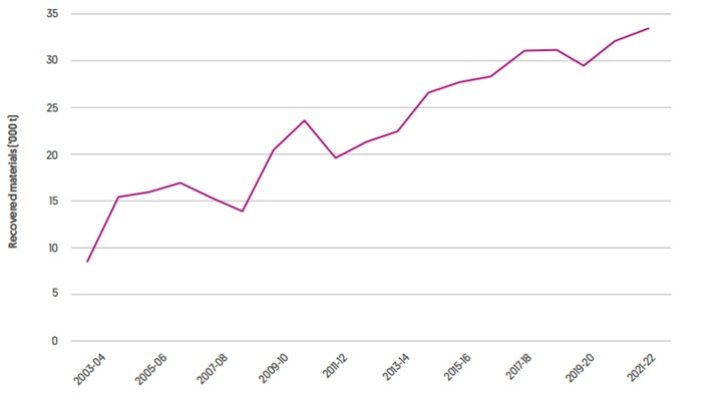
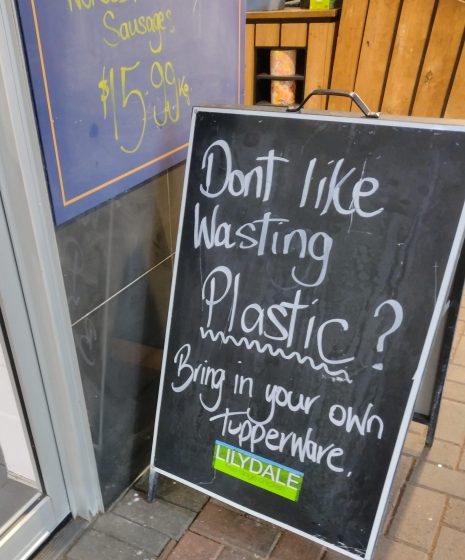
Benefits of Recycling
The benefits of recycling are enormous. For 2021–22, it is estimated that in South Australia:
- 1.52 million tonnes of carbon dioxide equivalent in greenhouse gases were not emitted to the atmosphere. This is approximately equivalent to the annual emissions of 303,000 cars and CO2 absorbed by 2.26 million trees
- 18,500 terajoules of energy were saved, which is about the same energy value that is used by 362,000 households in 1 year
- 8,400 ML of water was saved, which is equivalent to the volume of water that is contained in 3,400 Olympic-sized swimming pools and used annually by 51,000 households.
Challenges and Opportunities
Pressures
- Increasing waste production with increasing population.
- Economies of scale and transport challenges in the implementation of circular economies for regional centres resulting in increased costs to recycle and reuse wastes.
- Waste not being disposed of appropriately with people placing waste in the wrong bin, or no recycling/green waste bins being available to deposit recyclables and organic waste.
- Landfillnfees potentially leading to illegal dumping.
- Limited opportunities to recycle soft plastics with REDcycle currently not operating.
- Disasters such as floods and bushfires are likely to be more frequent with climate change. These events can result in the generation of significant volumes of waste that need to be managed and disposed of.
- Emerging streams like microplastics, PFAS-contaminated soils, wind turbines, PV solar panels and lithium-ion batteries from EV and energy storage. A Uni SA report anticipates waste generated by 100,000 tonnes of panels due to be dismantled in Australia from 2035.


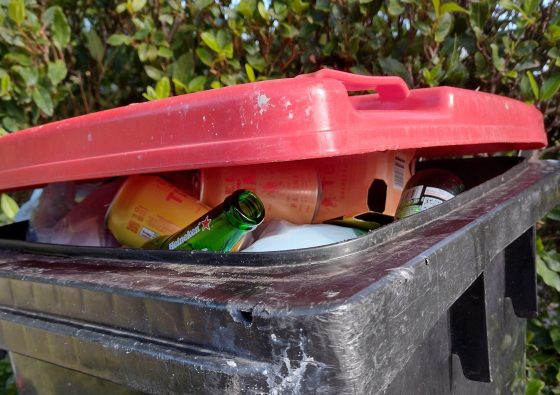
Impacts
- Less waste recovered resulting from people placing waste in the wrong bin, and costs associated with recycling in regional centres. The recovery rate of kerbside waste for metropolitan councils is 51% and regional councils is 40%.
- Contamination of products that could have been recycled or composted, which need to be diverted to landfill instead.
- Illegal dumping influenced by expensive landfill disposal fees. However, these fees should be encouraging people to also reduce their waste, therefore resulting in less waste needing to be disposed of at landfill sites.
- Increased risk of fires caused by the incorrect use and disposal of lithium-ion batteries.
- Food waste that goes to landfill produces methane, a greenhouse gas which, in turn, contributes to climate change.
- Containers are ending up in landfill or recycled as lesser quality products instead of being recovered for high-value reuse.
- Disaster events can lead to significant volumes of waste being generated that need to be managed and disposed of, which takes time, resources and money.
- Waste affects ecosystems, biodiversity and human health.
Responses
- South Australia's Waste Strategy 2020–2025 outlines high-impact and specific action for new directions, including food waste and single-use plastics, regulatory waste reforms, education and behaviour change, and, importantly, supporting market development and remanufacturing.
- Green Industries SA and the EPA work together to support South Australia’s transition to a circular economy and achieve the objectives of South Australia’s Waste Strategy.
- South Australia’s Single-use and Other Plastic Products (Waste Avoidance) Act 2020 was the first legislation of its kind in Australia. South Australia has been prohibiting the sale/supply of particular items to reduce the reliance on plastics and encourage reusable alternatives. To date, the state government has phased out plastic straws, cutlery and stirrers (in March 2021), polystyrene cups, bowls, plates, clamshell containers and oxo-degradable plastic products (in March 2022) and plastic-stemmed cotton buds, single-use plastic bowls and plates, and plastic pizza savers (in September 2023). Many other products are scheduled to be phased out in September 2024 and September 2025. More items will be added to this legislation over time. Replace the Waste.
- South Australia’s Container Deposit Scheme is currently being reviewed to modernise the scheme and increase the recovery and recycling of beverage containers.
- Green Industries SA has developed a circular procurement knowledge hub that promotes circular economy principles for purchasing decisions, including rethinking the need for purchase, the use of shared models, and reuse and refurbishment of existing assets.
- The South Australian Waste Strategy 2020–25 includes a key target for Regional Waste Management Plans to be in place for South Australian regional local government areas and/or regional city clusters by 2023, which are to include regionally appropriate and progressive waste diversion targets, for example, Waste and Resource Recovery Strategy 2021–2026 by the Legatus Group and Regional Waste Management Program Limestone Coast LGA. The South Australian Regional Organisation of Councils has produced a Regional SA Waste and Resource Recovery Background Report that highlights challenges, opportunities and considerations to help inform the development of waste and resource recovery strategies for regional areas.
- Circular economy opportunities have been developed for the Murraylands and Limestone Coast.
- The building and construction industry is currently both the largest consumer of materials and the global economy’s biggest emitter of greenhouse gas emissions. Circular Economy in South Australia’s Built Environment Action Plan (2023) summarises circular economy opportunities in the built environment for South Australia. The report outlines key actions and stakeholders that will need to work collaboratively to drive the transition from a linear to a circular economy and improve design, construction and use of our built environment to ensure our buildings are affordable, sustainable and climate-resilient.
- Establishment of stewardship schemes to encourage the recycling of products have been facilitated by the Australian Government. A product stewardship scheme has been proposed by Uni SA to manage the recycling of solar panels.
- Educational resources have been produced to help inform the community about how to appropriately dispose of and recycle waste. For example, wipe out waste, a website aimed at school kids to help support learning about reducing waste at schools and which bin, is a tool to help identify what waste goes into what bin.
- Green Industries SA (GISA) has been the lead agency in the clean-up and removal of waste following the 2019–20 bushfires and the 2022–23 Murray River floods. Disaster Waste Management Guidelines (2022) have now been produced by GISA that provide an emergency management framework to enable more effective and efficient management of post-disaster debris that will lead to more positive outcomes for human health and the environment. The EPA also provides guidance on the management of bushfire and flood waste.
- The EPA has released an interim guideline for the reuse of soils containing PFAS.
- GISA has produced a strategy Valuing Our Food Waste (2020–2025) to help address the 200,000 tonnes of food waste that is being sent to landfill every year in South Australia.
- SA Better Practice Guide: Sustainable Kerbside Services 2023 is a toolkit produced by GISA to help support councils in improving kerbside recycling services and better uptake of recycling by residents, thereby reducing organic waste that is sent to landfill.
- SA Organics Sector Analysis Summary (2021) has been produced to measure the South Australian organics processing sector’s current economic and environmental contribution and its capacity to support further transition to a circular economy and potential new opportunities.
- Food waste research was undertaken by GISA in June 2022 to help identify barriers to householders diverting food waste for composting. A lack of knowledge about what could be recycled in the green bin or a lack of willingness (too much effort or time needed) were reasons expressed for not recycling.
- Commitment by Australia's Environment Ministers to transition Australia from a ‘take, make, waste’ economy to a circular economy that maximises the values of materials and minimises waste and pollution. It was agreed to include:
- the development of a national framework to direct Australia’s transition to a circular economy
- mandate obligations for packaging design to include regulation to remove harmful chemicals and other contaminants in packaging
- development of a national roadmap for staged improvements to harmonising kerbside collections that consider metropolitan, regional and remote communities.
Opportunities
- New waste streams are emerging including electrical equipment, lithium-ion batteries and retired wind turbines. Recycling of soft plastics (with the closure of REDcycle), electrical equipment waste, waste from disasters such as fires and floods, and waste from end-of-life renewable energy infrastructure (for example, lithium batteries, solar panels and wind-farm blades) also need to be considered.
- Better education and initiatives are required to drive improved recycling of plastics and food waste both in businesses and households. Recovery rates from kerbside collections in metropolitan councils is only 51.5%, which is below the target of 70% waste diversion by 2025. Further single-use plastic bans will be implemented in the coming years.
- Continue the implementation of prohibitions of certain plastic products and expand education for reusable alternatives. Opportunities could include implementing circular design to minimise the potential for producing waste products and ensure that products are designed to be repaired or recycled.
- Improve the provision/availability of recycling and organic services for communities and businesses including the hospitality industry. About 99% of households live in a council area that provides a residual waste service. However, this reduces for recycling and organics, which is 97% for recyclables and 91% for organics. Use of green waste and recycling bins should be encouraged at places such as caravan parks and other accommodation places, major events and for the hospitality industry.
- Expand green waste collection (food organics and garden organics FOGO) and free hard-waste collection, which are already implemented by some councils across South Australia. It appears that approximately 59% of councils have introduced FOGO waste collection services.
- Investigate introducing requirements for food waste separation and collection, particularly for the commercial and industrial sector.
- Provide leadership, education, investment and support for implementation of a circular economy, and consider regional areas during this approach.
- Provide incentives for waste prevention, reuse and recycling. Expand and facilitate further opportunities to swap goods that otherwise may go to landfill or be dumped.
- Support the development and implementation of product stewardship schemes for the management of problematic waste, for example, solar panels.
- Investigate expanding landfill bans to include waste that has established resource recovery pathways (such as those that are included within national product stewardship schemes).
- Research and plan to identify, quantify and facilitate the management of emerging waste streams and ensure this is considered and actioned within our circular economy.
- Identify reasons for what is causing the low return rates for PET and HDPE plastic containers.
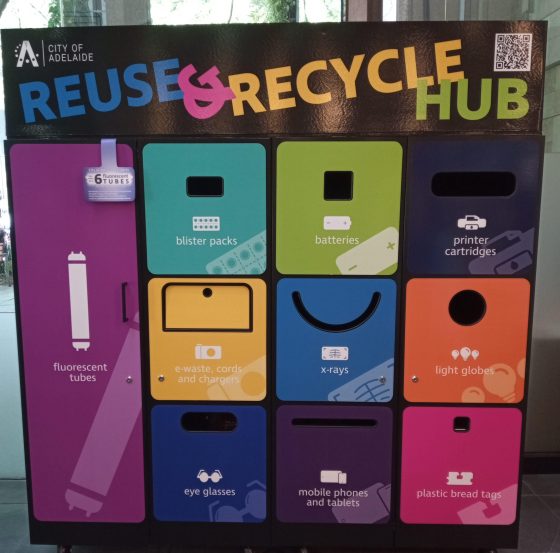
Further Reading
- National Waste Report 2022 – Prepared for the Department of Agriculture, Water and the Environment.
- GISA Strategic Plan 2021–2025
- South Australia’s Waste Strategy 2020–2025 – Outlines actions that can contribute to the implementation of a circular economy for South Australia.
- Circular economy resource recovery report 2021–22 – Summarises the quantities of ‘waste’ that has been diverted from landfill via recycling, reusing or energy recovery.
- Circular economy in South Australia’s built environment Action Plan (2023) – Summarises circular economy opportunities for South Australia.
- Case studies – Green Industries SA case studies on showcasing achievements of South Australians in improving waste management and resource efficiencies.
- What to do about plastics 2023 – An independent report by Mr Vaughan Levitzke PSM, Circular Economy Advisory, commissioned by the EPA which discusses issues associated with the management of plastics in South Australia.
- CSIRO Tackling plastic waste and Ending plastic waste – Information about research that is being undertaken to reduce production of plastic waste.
- National Plastics Plan 2021 – Identifies actions to tackle plastic waste.
- Circular procurement knowledge – Provides tools, guidelines, case studies and training that will help incorporate circular economy principles into procurement
- Replace the waste website – Information on how to avoid using plastics.
- Solving Plastic Waste CRC – Help drive circular economy by facilitating research and development.
- Ending plastic waste – CSIRO publications on ending plastic waste.
- SA better practice guide: sustainable kerbside services – Practical information and tools to SA councils on introducing the Sustainable Kerbside Service.
- Disaster waste management
- Food waste strategy 2020-25 – Integrates policy measures, behavioural change actions and support for industry to address the estimated 200,000 tonnes of food waste sent to landfill each year in South Australia
- Implementing the Circular Economy in Regional South Australia: Identifying Targets and Developing Partnerships
- Lithium-Ion Battery Recycling Opportunities in SA – Outlines a vision for South Australia to manage lithium-ion battery waste.
- A circular economy roadmap for plastics, tyres, glass and paper in Australia 2021 CSIRO – A report by CSIRO that identifies opportunities for how waste can be avoided and materials can be reused or recycled.
- End Food Waste Australia – Facilitate research and development into reducing food waste in Australia.
- Keep Australia Beautiful and Kesab – Contains tools and information to help manage the impacts of waste on the environment.
